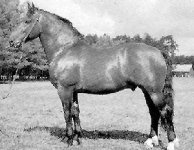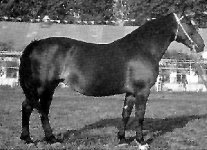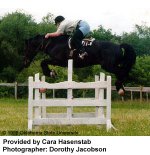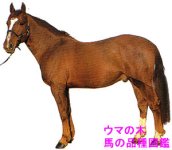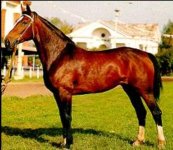♘امیرحسین♞
♘ مدیریت انجمن اسب ایران ♞
Also Known As: Latviiskaya (Russian), Latviiskii upryazhnyi (Russian), Latvian Carrige, Latvian coach, Latvian Draft
The Latvian breed was developed in Latvia from the beginning of the 20th century up to 1952 by crossing the native horses with west European harness and harness-saddle breeds. Oldenburg, Hanoverian and to a less extent Holstein stallions had most influence. Between 1921 and 1940, 65 Oldenburg stallions and 42 Oldenburg mares were imported from the Netherlands and Germany; they became the core of the breed. Besides the purebred Oldenburgs, Oldenburg crosses and Hanoverian, Norfolk Roadster, Ardennes and East Friesians were widely used. A special role in breed formation was played by the Okte stud in the Talsa region.
Two types, the harness horses and the equestrian sports horses, have been evolved. Prior to 1960, the harness type was emphasized. Subsequently, as mass scale equestrian sports developed in Latvia on a large scale, the number of horses of the sport type was increased through infusion of the Hanoverian and, to a less extent, Thoroughbred blood.
The modern Latvian is a successful combination of the features of the utility and saddle horses. Tall, heavy muscled and bony, in format they are intermediate between saddle and harness horses. Latvians have a well-proportioned and solid build; the joints are sometimes coarse. Muscles are well developed, bone structure solid, chest broad, withers moderately pronounced or high and long and with a normal slope, legs properly set and with well-developed knee-joints and hocks. Defects include short and ringboned pasterns and cow hocks. The commonest colour are bay, brown and black; chestnut is less frequent.
The average measurements (in cm) of stallions are: height at withers 164, oblique body length 166, chest girth 190, cannon bone girth 23. Taller stallions (168-170 cm) are now being used due to the popularity of the riding type. The average measurements (in cm) of the mares are 161, 167, 191 and 22 respectively.
Latvian horses have shown good results in performance tests both in harness and under saddle, particularly in competitions. The records are 2000 m draught walk with a pull of 150 kg, 13 min 40.6 sec; 2000 m draught trot with a pulling effort of 50 kg, 4 min 36.8 sec; draught endurance with a pull of 300 kg, 1537 m and the maximum pull 927 kg.
The breed consists of 2 intra-breed types, harness and sport horses, and of 4 major lines.
Pure breeding and limited crossing with Hanoverian and Oldenburg stallions are the main improvement methods. The best farms are Burnieke state farm, Uzvere and Tervete collective farms and the Sigulda experimental farm of the Institute of Animal Breeding.
The Latvian breed was developed in Latvia from the beginning of the 20th century up to 1952 by crossing the native horses with west European harness and harness-saddle breeds. Oldenburg, Hanoverian and to a less extent Holstein stallions had most influence. Between 1921 and 1940, 65 Oldenburg stallions and 42 Oldenburg mares were imported from the Netherlands and Germany; they became the core of the breed. Besides the purebred Oldenburgs, Oldenburg crosses and Hanoverian, Norfolk Roadster, Ardennes and East Friesians were widely used. A special role in breed formation was played by the Okte stud in the Talsa region.
Two types, the harness horses and the equestrian sports horses, have been evolved. Prior to 1960, the harness type was emphasized. Subsequently, as mass scale equestrian sports developed in Latvia on a large scale, the number of horses of the sport type was increased through infusion of the Hanoverian and, to a less extent, Thoroughbred blood.
The modern Latvian is a successful combination of the features of the utility and saddle horses. Tall, heavy muscled and bony, in format they are intermediate between saddle and harness horses. Latvians have a well-proportioned and solid build; the joints are sometimes coarse. Muscles are well developed, bone structure solid, chest broad, withers moderately pronounced or high and long and with a normal slope, legs properly set and with well-developed knee-joints and hocks. Defects include short and ringboned pasterns and cow hocks. The commonest colour are bay, brown and black; chestnut is less frequent.
The average measurements (in cm) of stallions are: height at withers 164, oblique body length 166, chest girth 190, cannon bone girth 23. Taller stallions (168-170 cm) are now being used due to the popularity of the riding type. The average measurements (in cm) of the mares are 161, 167, 191 and 22 respectively.
Latvian horses have shown good results in performance tests both in harness and under saddle, particularly in competitions. The records are 2000 m draught walk with a pull of 150 kg, 13 min 40.6 sec; 2000 m draught trot with a pulling effort of 50 kg, 4 min 36.8 sec; draught endurance with a pull of 300 kg, 1537 m and the maximum pull 927 kg.
The breed consists of 2 intra-breed types, harness and sport horses, and of 4 major lines.
Pure breeding and limited crossing with Hanoverian and Oldenburg stallions are the main improvement methods. The best farms are Burnieke state farm, Uzvere and Tervete collective farms and the Sigulda experimental farm of the Institute of Animal Breeding.

